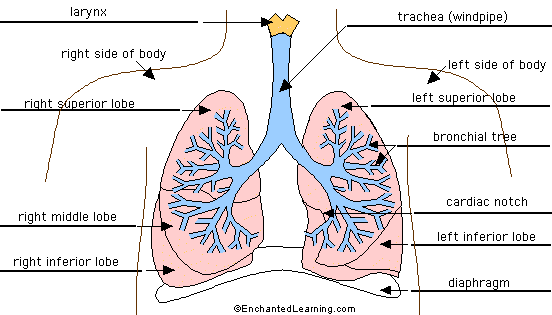respiratory system

Lung Anatomy |
The lungs are respiratory organs -- we use them to breathe. We breathe in order to get oxygen (O2) and to get rid of carbon dioxide (CO2).
We breathe in through the nose or mouth. The air then goes through the larynx and the trachea (also called the windpipe) and into the lungs. We breathe by using the diaphragm, a muscular membrane under the lungs. When the diaphragm the diaphragm contracts and pulls downwards, the lungs expand and air enters the lungs (inhalation). When the diaphragm relaxes, air is exhaled from the lungs.
When the air is in the lungs, it comes enters capillary-lined alveoli (singular alveolus). In the hollow alveoli, gas exchange occurs [oxygen (O2) is absorbed by blood in the capillaries and carbon dioxide (CO2) is gotten rid of].
People have two lungs -- they are located on either side of the heart within the rib cage. The two lungs are not identical; the right lung has three lobes and the left lung has two lobes.
Lung Glossary
alveoli (singular alveolus) - hollow, capillary-lined structures within the lungs that are the site of gas exchange with the blood [the absorption of oxygen (O2) and the loss of carbon dioxide (CO2)]. Each human lung contains about 300 million alveoli. |
|
0 comentarios